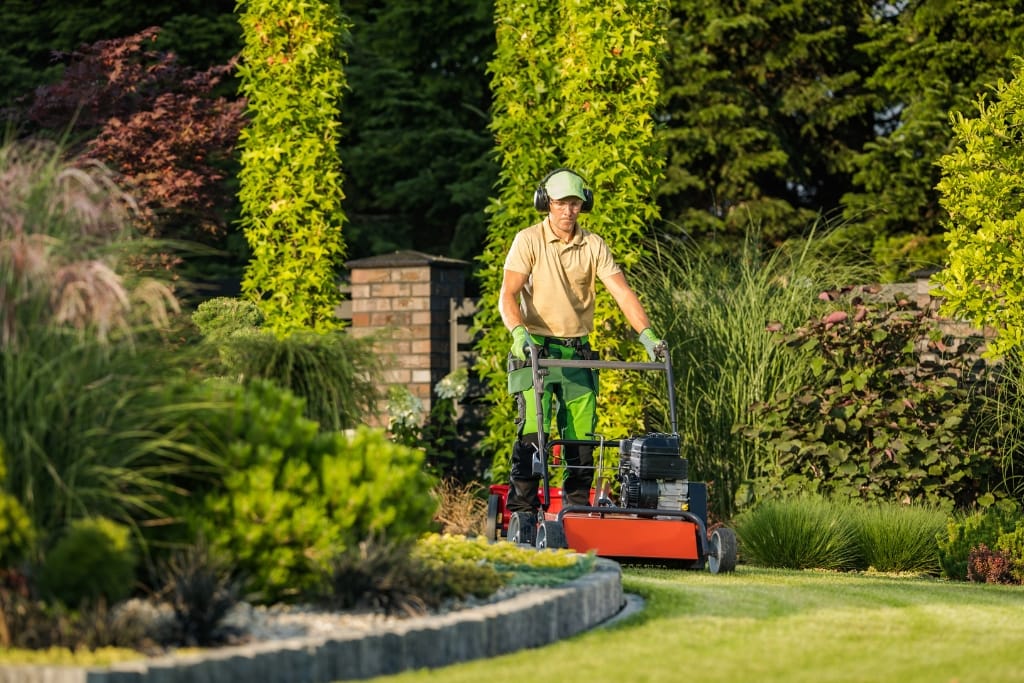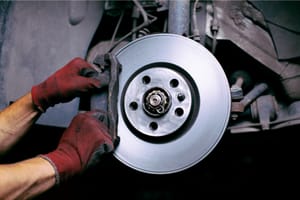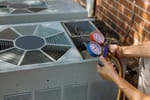Do you want a beautiful and lush lawn that will make your neighbors green with envy?
Maintaining a healthy and lush lawn can seem tedious, but proper maintenance is easier than you might think.
Here are ten tips for effective lawn maintenance and the perfect yard that all homeowners can do without the help of professional landscapers or gardeners.
1)) Sharpen Your Mower Blades
A dull mower blade rips the grass, making it more susceptible to disease and pests.
Keep your mower in tip-top condition by sharpening the blades at least twice a year to ensure a clean, healthy cut.
Clean the mower to avoid spreading disease or pests around the lawn.
Tips to Sharpen Your Mower Blades Properly:
- Choose the Right File: It's important to select the appropriate file for sharpening your mower blades. Typically, a 10-inch mill bastard file will do the trick. Ensure the file is of good quality for the best results.
- Secure the Blade: For safety and effectiveness, secure the blade in a vice before you start filing. This will keep the blade steady and prevent potential accidents.
- Maintain the Right Angle: When filing, aim to maintain the blade's original angle. Typically, this is about a 40-45 degree angle. Remember to file in one direction only, pushing the file away from your body for safety.
Sharpening your mower blades is a straightforward task that plays a crucial role in maintaining a healthy lawn.
By choosing the right file, securing the blade properly, and maintaining the correct angle, you can ensure an efficient, clean cut that benefits your lawn's overall health.
A well-maintained mower is an essential tool in your lawn care arsenal.
Pro-Tip: Using a Lawn Mower Blade Sharpening Kit greatly simplifies the process of sharpening dull blades. These kits include all the necessary tools and instructions, eliminating the guesswork and ensuring a sharper, more efficient blade. A well-sharpened blade not only cuts the grass more efficiently but also reduces the strain on your mower's motor. This in turn prolongs the life of your lawn mower, making your lawn care efforts more effective and cost-efficient.
2)) Mow At The Right Height
Set your mower to the correct height to ensure healthy grass growth.
Cutting your lawn too short will harm the grass by damaging the roots and allowing weeds to take over while setting the blade too high will result in long, weak grass that's more fungus-prone.
Tips for Mowing at the Right Height:
- Understand Your Grass Type: Different grass types have different optimal heights. For instance, Bermuda grass thrives when cut to a height of 1.5 inches while Kentucky bluegrass is best maintained at 2.5 inches. Do your research to know what height is best for your lawn.
- Adjust Your Mower: Once you know the optimal height for your grass type, adjust your mower's blade height accordingly. Most mowers have a simple lever that allows you to easily change the blade height.
- Avoid Scalping: Never cut more than a third of the grass blade at once. Cutting too much can stress the grass, making it more susceptible to pests and disease. If your lawn has grown too long, mow it in stages, gradually lowering the blade height over a few mowing sessions.
Adhering to the correct mowing height is paramount in achieving a lush, healthy lawn.
By understanding your specific grass type and adjusting your mower's height accordingly, you can promote robust grass growth.
Avoid scalping; mowing in stages if necessary to protect your lawn from undue stress.
With these techniques, you can ensure your yard is not just visually appealing, but also resistant to pests and disease.
3)) Water The Lawn Effectively
Effective watering is essential for lawn health. Water your lawn deeply and infrequently, rather than often and shallowly.
Water in the early morning or late evening to avoid evaporation and sun scorch.
Tips for Watering Your Lawn Effectively:
- Measure Your Watering: To ensure you're watering deeply enough, place a small, empty tuna can in your lawn while you water. Once the can is full, you've watered enough. Typically, lawns need 1 to 1.5 inches of water per week.
- Water at the Right Time: The optimal time to water your lawn is early in the morning when the sun is low, winds are calm, and temperatures are cool. This reduces the amount of water lost to evaporation. If you can't water in the morning, late afternoon is the next best time.
- Use a Sprinkler System: If you have a large lawn, consider investing in a sprinkler system. This ensures even watering across your entire lawn and can be automated to water at the right times, making the process easier and more efficient.
Effectively watering your lawn contributes significantly to its overall health and aesthetic appeal.
By measuring your watering, timing it correctly, and considering the use of a sprinkler system, you can optimize the hydration your lawn receives.
These straightforward and effective measures ensure your lawn stays lush, vibrant, and healthy, enhancing the beauty and enjoyment of your outdoor space.
4)) Use A Fertilizer
Fertilize your lawn at least once a year with a slow-release fertilizer and follow the instructions on the package for exact timing and dosage.
Avoid applying fertilizer too frequently, as it can lead to thatch build-up.
Tips for Using Fertilizer Effectively:
- Choose the Right Fertilizer: Not all fertilizers are created equal. The right fertilizer for your lawn depends on your soil's nutrient needs and the type of grass you have. Conducting a soil test can help you determine these needs.
- Follow Packaging Instructions: Overfertilizing can damage your lawn. Always adhere to the dosage instructions on the fertilizer packaging. The manufacturer's recommendations provide the safest and most effective application rate.
- Use a Spreader: To ensure even application, use a spreader. Hand-spreading can lead to clumps or patches of fertilizer, which can burn your lawn. A broadcast or drop spreader can provide a more uniform distribution.
Employing the proper use of fertilizer is a significant step towards cultivating a vibrant and healthy lawn.
Selecting the correct type of fertilizer, adhering to package instructions, and using a spreader for even distribution are critical considerations.
With these measures, you can ensure that your lawn receives the essential nutrients it needs for optimal growth and resilience, without the risk of overfertilization or uneven distribution.
5)) Aerate Your Lawn
Aeration is the process of creating small holes in the lawn that will enable the lawn to breathe and grow better.
Aerate around once a year, ensuring the soil stays moist.
Tips for Aerating Your Lawn Effectively:
- Choose the Right Time: The best time to aerate your lawn is during the growing season when the grass can heal and fill in any open areas after soil plugs are removed. Ideally, aerate your lawn in the early spring or fall for cool-season grass and late spring for warm-season grass.
- Ensure Moist Soil: Soil should be moist before aeration. If the soil is too dry, the aerator will have difficulty penetrating it. Water your lawn one to two days before aerating to achieve optimal soil moisture.
- Use the Correct Equipment: There are various types of lawn aerators, including spike and plug aerators. Plug aerators are generally more effective as they remove a core of grass and soil from the lawn. Spike aerators can cause soil compaction in the areas around the holes.
Aerating your lawn is an essential part of lawn maintenance, promoting healthier and more vigorous growth.
Careful timing, ensuring soil moisture, and using the correct aeration equipment will foster optimal conditions for your lawn to thrive.
By incorporating these practices, you can significantly improve your lawn's overall health and appearance, making it more resilient and enjoyable throughout the year.
6)) Remove Weeds
Weeding your lawn is important as it allows the grass roots to breathe in the air while removing unwanted plants.
You can remove weeds using a chemical application or manually pulling them out.
Tips for Removing Weeds Effectively:
- Identify the Type of Weeds: Understanding the type of weeds invading your lawn can help you devise an effective removal strategy. Some weeds are annual, while others are perennial, and each requires different management techniques.
- Manual Removal: For a small number of weeds, manual removal can be effective. Use a weeding tool to remove the weed and its root system from the soil to prevent regrowth.
- Use of Herbicides: For larger infestations, consider using a selective herbicide designed to kill the weeds without harming your grass. Always follow the manufacturer's guidelines for application to ensure safety and effectiveness.
Effectively removing weeds from your lawn can significantly contribute to its health and appearance.
By identifying the types of weeds present, manually removing them when possible, and using herbicides responsibly when necessary, you can keep your lawn weed-free.
These strategies can help ensure that your lawn remains a vibrant and enjoyable outdoor space that is resilient against future weed invasions.
7)) Monitor Pests & Diseases
Regularly monitor your lawn for pests and diseases. Look for the signs of disease and pests and use an appropriate treatment when required.
Sometimes, preventive measures like regularly aerating the soil and fertilizing are the best disease and pest prevention measures.
Tips for Monitoring Pests and Diseases Effectively:
- Regular Inspection: Regularly walk around your lawn and inspect it for signs of pests and diseases. This could include discoloration, wilting, unusual spots, or the presence of pests themselves.
- Identify Early: Early identification of pests and diseases is key for effective treatment. Familiarize yourself with common lawn pests and diseases in your area to better know what to look for.
- Use Appropriate Treatment: If you identify pests or diseases, use the appropriate treatment for each. This may be a pesticide, fungicide, or other treatment method. Always follow the manufacturer's instructions to ensure effective and safe use.
Regularly monitoring your lawn for pests and diseases allows for early detection and treatment, crucial for maintaining a lush, healthy environment.
Through regular inspections, early identification of common issues, and applying appropriate treatments as per instructions, you can mitigate the damage caused by pests and diseases.
These measures will ensure your lawn remains a vibrant, healthy space for you to enjoy.
8)) Add A Lawn Edging
Adding an edge to your lawn provides clean edges and makes your lawn look more organized. Use a sharp spade to make a clean edge, or you can purchase edging.
Tips for Adding Lawn Edging Effectively:
- Choose the Right Material: Lawn edging materials can vary from metal, plastic, and stone, to wood. Choose a material that complements your garden's aesthetic and is durable enough to withstand outdoor conditions.
- Use a Sharp Tool: If you're creating a natural edge with a spade, ensure the tool is sharp. This will help you cut through the grass and soil more easily, creating cleaner lines.
- Maintain Regularly: Over time, your lawn may start to grow over your edging. Regular maintenance, such as trimming the edges, will keep your lawn looking neat and well-defined.
Adding lawn edging enhances the visual appeal of your outdoor space, lending it a clean, organized appearance.
By carefully selecting the right edging material, using sharp tools for precision, and committing to regular maintenance, you can ensure that your lawn's edges remain well-defined and attractive.
This element of garden care is a simple yet impactful way to elevate the overall look of your lawn.
Pro-Tip: Investing in a string trimmer comes with a host of benefits, particularly for maintaining the edges of your lawn. String trimmers allow you to reach tight spots mowers can't, ensuring a uniform, tidy appearance. Furthermore, these tools are ideal for shaping and defining borders around walkways, flower beds, and other landscaping elements. By providing precision and versatility, a string trimmer is an indispensable tool for achieving a well-manicured lawn.
9)) Keep A Thick Layer Of Mulch
Mulching is important to keep the soil nutrients and moisture. It also controls the weeds and prevents soil erosion.
Tips for Maintaining a Thick Layer of Mulch Effectively:
- Choose the Right Mulch: There are various types of mulch available, each with its benefits. Organic mulches, like wood chips or compost, can improve soil health as they decompose, while inorganic mulches, such as gravel or rubber, are more durable and require less maintenance.
- Apply the Right Amount: Too little mulch may not effectively retain moisture, but too much can hinder water and air penetration into the soil. Generally, a 2-3 inch layer of mulch is recommended.
- Replenish Regularly: Over time, organic mulch will break down and contribute to the soil's nutrient content. Therefore, make sure to regularly replenish your mulch layer to maintain its effectiveness.
Maintaining a thick layer of mulch in your garden is a crucial aspect of holistic lawn care.
By using the correct type of mulch, applying an appropriate amount, and regularly replenishing as needed, you can promote soil health, conserve moisture, control weeds, and prevent erosion.
With these steps in mind, mulching can play a significant role in creating a lush, vibrant, and healthful lawn environment.
10)) Make Your Yard Insect Repellent
Repel insects using these home remedies. You can use many home remedies to get rid of bugs and mosquitoes without using chemicals.
Garlic, mint oil, lavender, and lemongrass are some natural remedies to prepare natural insect repellent.
Tips for Making Your Yard Insect Repellent Effectively:
- Utilize Natural Ingredients: Use natural ingredients like garlic, mint oil, lavender, and lemongrass to create effective insect repellents. These are non-toxic alternatives to chemical repellents and are usually safer for use around children and pets.
- Plant Insect-Repelling Flora: Certain plants naturally repel some insects. Consider planting marigolds, citronella, or lavender in your garden to deter pests.
- Maintain Cleanliness: Regularly clean your yard to remove potential insect breeding sites. This includes disposing of standing water and keeping your lawn trimmed.
Making your yard insect repellent can significantly enhance your outdoor experience by reducing the nuisance and potential harm of pests.
Utilizing natural ingredients to create repellents, growing insect-deterring plants, and maintaining cleanliness in your yard are all effective strategies.
This not only ensures a bug-free environment but also contributes to a healthier, more balanced garden ecosystem.
Conclusion
Your lawn is an essential part of your home exterior and enhances the overall beauty of your property.
These ten easy lawn maintenance tips can help you maintain a healthy and luscious garden that the neighbors envy.
By creating an effective lawn care routine, you will soon have the perfect yard to make your friends envious and increase your house's curb appeal.
Related Articles and Guides:
- How To Get A Green Lawn Without Weeds
- 10 FAQs About How To Make Your Lawn Green
- 10 Lawn Care Tips For Spring
- 10 Lawn Care Tips For Summer
- 10 Lawn Care Tips For Fall
- 10 Lawn Care Tips For A Thriving Yard
Download Our Free E-book!








